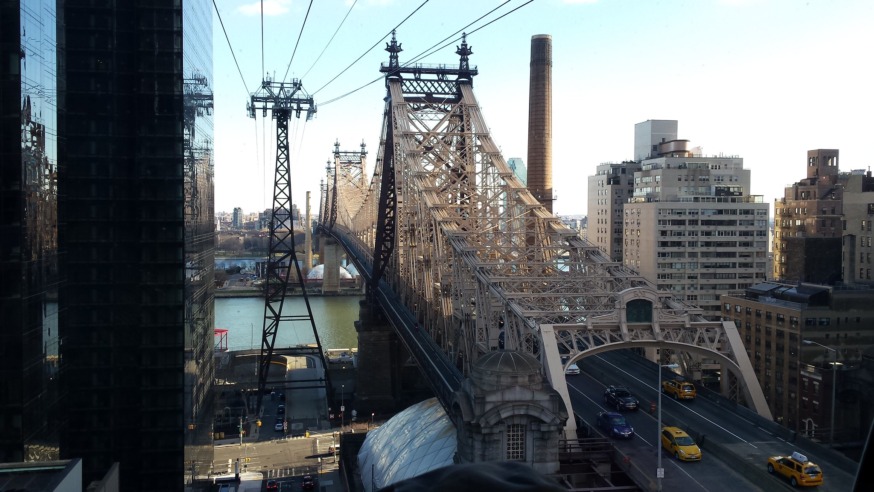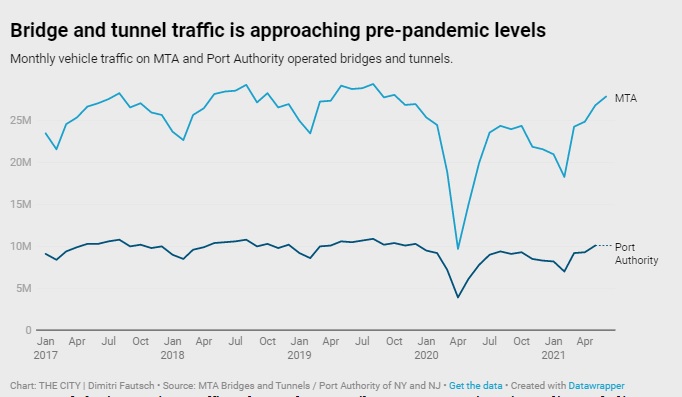
Queensboro Bridge (NYCDOT Flickr)

This article was originally published
by The CITY on
BY Jose Martinez
Traffic has rebounded to pre-pandemic levels on bridges and tunnels across the city, data shows — spurring concerns that New York is headed “right back to gridlock” as mass transit use lags.
More than 27.9 million vehicles crossed the nine tolled crossings controlled by the MTA last month, according to the transit agency, the most since October 2019, when the number of paid trips hit 28.1 million.
Meanwhile, the Port Authority of New York and New Jersey’s six bridges and tunnels logged more than 10.1 million vehicle trips in May, the most since the 10.3 million tallied in December 2019.
The busiest Port Authority span — the George Washington Bridge — saw its monthly number of vehicle crossings grow from nearly 3.6 million in January to 4.3 million in May, data shows.
The city’s Brooklyn, Manhattan, Williamsburg and Ed Koch Queensboro bridges recorded 246,044 Manhattan-bound vehicle crossings in May, according to Transportation Department numbers. That’s the highest since February 2020, when 249,486 vehicles traversed the East River spans, a month before the pandemic paralyzed the city.

George Washington Bridge (Photo: Famartin CC BY-SA 4.0)
“Now you feel the traffic going back to what it used to be,” said Mateo Muñoz, 32, who drives through the Lincoln Tunnel from Union City, N.J., to his job as a building maintenance worker on the Upper West Side. “No more 20-minute trips like early in the pandemic, so now I have to wake up 45 minutes earlier to get to work on time.”
The increase comes even as the average gas price in the metropolitan area increased for the sixth straight month to $3.04 a gallon in May — up nearly 40 cents from November 2019, according to federal statistics. It also comes with less than 30% of employees expected to return to Manhattan offices by the end of this month, a June survey by the Partnership for New York City found.
“We’re really alarmed by the trend, especially because transit ridership remains below 50% of pre-pandemic levels,” said Liam Blank, a spokesperson for Tri-State Transportation Campaign. “It seems like we’re going right back to gridlock.”

He noted the increasing traffic volume also contributes to worsening air quality and climate change throughout the region.
“The worst effects, including high rates of asthma, infant mortality, and upper respiratory diseases, will be felt in historically disadvantaged communities of color and low-income areas that lack transit accessibility and are often located adjacent to highways,” Blank said.
“Tailpipe emissions contribute to rising temperatures, which in turn makes our region hotter and more susceptible to stronger storms and flash floods that destroy property and make underground transit service much more vulnerable.”
‘More Time on the Road’
Toll increases on MTA crossings also took effect in April, while the Port Authority last hiked fees in January 2020.
The number of monthly trips across bridges and tunnels plummeted in the early days of the pandemic, with trips on MTA crossings sinking to 9.7 million in April 2020 — down from 27.4 million in April 2019.
The collapse in crossings did not last long.

Since June of last year, the number of trips on MTA bridges and tunnels has topped 20 million every month except for February (which was extremely snowy), hitting 26.8 million in May. In July, MTA data shows, the number of trips have been off by only a few percentage points from equivalent pre-pandemic days, while subway and bus ridership remains down more than 50%.
“We are concerned about it,” MTA Chairperson Patrick Foye told THE CITY. “We are doing everything we can to drive customers, former customers, new customers, to mass transit.”
At Port Authority crossings, the number of trips in May was more in line with figures from 2019, when all but two months had at least 10 million trips. In April 2020, there were just 3.9 million trips on the bi-state agency’s bridges and tunnels.
While the MTA’s subways, buses and commuter railroads face potential service cuts by 2023 if ridership does not bounce back to pre-pandemic levels, the bridges and tunnels have nearly returned to 2019 levels, when there were nine months with more than 27 million crossings.
Bridge and tunnel toll revenue accounted for 12% of the agency’s nearly $17 billion budget in 2019 and is expected to provide 11% of the 2021 budget.
“I’ve been feeling the traffic rising for months now,” said Lirdon Dautaj, 48, a doorman from Staten Island who drives across the Verrazzano-Narrows and Brooklyn bridges to his job in Manhattan. “That’s more time on the road every day.”
‘Putting a Price on Driving’
But with plans to toll vehicles driven into Manhattan’s central business district stalled, transit officials and advocates worry about increased pressure on the crossings and city streets as more people return to their workplaces.
“I think it’s clear validation and affirmation of the need for congestion pricing,” Foye said.
Mayor Bill de Blasio, who did not support congestion pricing until 2019, has repeatedly accused the state and the MTA of inaction on the tolling plan that was supposed to kick in this year.
Under congestion pricing, motorists entering Manhattan south of 60th Street would be tolled, with the revenue used to fund mass-transit improvements.
“The only thing that will really solve the congestion problem is by putting a price on driving with congestion pricing,” Blank said.
THE CITY is an independent, nonprofit news outlet dedicated to hard-hitting reporting that serves the people of New York.
3 Comments

Let’s remove all bike lanes and not give anyone anymore “transportation alternatives.” Traffic will get so much better! Believe ME/US. LOL
You’ll only fine me on the subway when the weather does not permit me to bike in.
Several thousand train runs continue to be canceled monthly due to a shortage of conductors and engineers. It takes three months for conductors and eight months for engineers to be fully trained. NYC Transit subway will not be fully staffed until some time in 2022.
Criminal activity, homelessness and vandalism keep many away. This needs to be dealt with if the MTA wants to see a return to pre-COVID 19 ridership of over five million daily customers. Police need to deal with more important issues than immigrant vendors selling Churro and other products underground. Return to the days when a transit police officer was assigned to ride each train and others patrolled stations. This, along with installation of security cameras on trains and stations might help to reduce the perception of growing crime.
Place more trash cans in stations. Install separate cans for recycling newspapers, plastic and glass, along with regular garbage. Sell advertising on the side of cans to generate revenue for covering the costs of more frequent collection and disposals.
Conductors need to refrain from closing the doors while riders attempt to cross the platform attempting transfers from a local to the express train. Reopen all closed bathrooms. Bring more stations in compliance with the Americans with Disabilities Act (ADA).
(Larry Penner — transportation advocate, historian and writer who previously worked for the Federal Transit Administration Region 2 NY Office. This included the development, review, approval and oversight for billions in capital projects and programs for the MTA, NYC Transit along with 30 other transit agencies in NY & NJ)
.